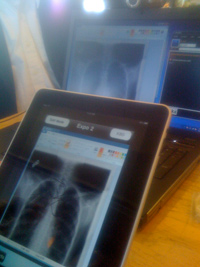![]() Dakama recently came across my desk as a new player in the mobile UC market, having been founded in 2004, with an interesting ‘spin’ around call handoffs. Called ‘sweeping‘ the company claims to be the first to “successfully demonstrate (the capability) across multiple networks and devices”. When I heard this, I disputed the claim since call handoff has been demonstrated and demonstrated and demonstrated since at least 2005. That year Cisco’s Jim Grubb demonstrated the FirstHand (then SIPquest) mobile client on a Windows Mobile smartphone initiating a call on WiFi and then handing it off to the GSM network without losing or interrupting the call. On stage. In front of dozens of industry analysts. I remember, not because I was there, but because I was working for SIPquest and we invested in promoting the milestone. There was even a video of the demonstration. I have a face-to-face briefing later in September and will ask to understand more about this claim at that time.
Dakama recently came across my desk as a new player in the mobile UC market, having been founded in 2004, with an interesting ‘spin’ around call handoffs. Called ‘sweeping‘ the company claims to be the first to “successfully demonstrate (the capability) across multiple networks and devices”. When I heard this, I disputed the claim since call handoff has been demonstrated and demonstrated and demonstrated since at least 2005. That year Cisco’s Jim Grubb demonstrated the FirstHand (then SIPquest) mobile client on a Windows Mobile smartphone initiating a call on WiFi and then handing it off to the GSM network without losing or interrupting the call. On stage. In front of dozens of industry analysts. I remember, not because I was there, but because I was working for SIPquest and we invested in promoting the milestone. There was even a video of the demonstration. I have a face-to-face briefing later in September and will ask to understand more about this claim at that time.
The company has development offices in both the US (Richardson TX area) and in India, is angel investor funded and has about 50 employees. Their goal is to be device and network independent and their channel to market is through mobile operators and managed service providers where they hope to co-brand their offer or white label the service.
Damaka does Video
More recently, the company announced that it has enabled video conferencing from iPhone 4 devices to any other device. This advanced feature offers great sizzle appeal and will enable their service offering as a differentiator for those market segments and classes of customers where the video service is particularly more valuable than it is for typical business users and panel members. These could be surveillance and security applications or remote diagnostic applications where the expert stays in the home office while the remote employee points the video at some strange machine setting or person. I would think we’ll be seeing lots of product placement opportunities on popular detective or crime dramas. Can’t you see Jack Bauer as a spokesman?
And among consumers, deaf people have only been able to use SMS and mobile IM (a form of SMS) to communicate with their friends and family and have used relay services to speak with others. To me, a 2-way portable video capability, particularly one that is not limited only to the Wi-Fi network, would be very useful. It would enable a communication where the deaf person can use American Sign Language to visually speak with an ASL-trained friend or family member and really see what that person had to say. The competition here though is texting and if hearing-impaired people are anything like my teenage kids, it will be tough to displace an SMS expert’s confidence and speed with SMS. I suppose the video will be better at showing facial inflections and emotions than what texting can do.









